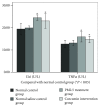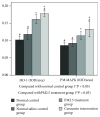Study on the Mechanism of Curcumin Regulating Lung Injury Induced by Outdoor Fine Particulate Matter (PM2.5)
- PMID: 31530996
- PMCID: PMC6721509
- DOI: 10.1155/2019/8613523
Study on the Mechanism of Curcumin Regulating Lung Injury Induced by Outdoor Fine Particulate Matter (PM2.5)
Abstract
Background: Epidemiological studies have shown that exposure to PM induces oxidative stress, leading to a variety of health problems. In particular, PM2.5 contains a lot of substances harmful to the human body and penetrates into the lungs to induce lung injury. At the same time, there is increasing evidence that oxidative stress also affects the severity of lung injury. However, there is still no good way to reduce or eliminate these hazards. In the future, more experimental research is needed to further confirm the mechanisms of these hazards and formulate effective preventive measures and treatment plans for their hazard mechanisms. Curcumin has been reported to reduce oxidative stress and inflammatory damage and protect organs.
Objective: To investigate whether curcumin can play a protective role against PM2.5-induced oxidative stress and inflammatory damage by inducing expression of the HO-1/CO/P38 MAPK pathway.
Methods: In this experiment, PM2.5 was dropped into the trachea to establish a lung injury model in mice. 28 SPF-grade male Kunming mice were randomly divided into 4 groups: normal control group, saline control group, PM2.5 treatment group, and curcumin intervention group. Albumin (ALB), lactate dehydrogenase (LDH), and alkaline phosphatase (ALP) were measured in alveolar lavage fluid (BALF) to assess lung tissue damage. Colorimetric detection of oxidative stress indicators such as MDA, GSH-PX, T-AOC, and CAT in the lung tissue was performed. The levels of IL-6 and TNF-α in the lung tissue were determined by ELISA. Histopathological examination was used for the assessment of alveolar epithelial damage. The protein expression of the HO-1/P38 MAPK pathway in the lung tissue was determined by Western blot and immunohistochemistry. Endogenous CO was detected by spectrophotometry. The results showed that the expression of the HO-1/CO/P38 MAPK protein in the lung tissue was significantly increased in the curcumin intervention group compared with the PM2.5 treatment group, and it was statistically significant (P < 0.05). Compared with the PM2.5 treatment group, the curcumin intervention group can reduce the amount of ALB, LDH, and ALP in BALF; reduce the levels of MDA, IL-1, and TNF-α in the lung tissue; and improve GSH-PX, T-AOC, and CAT levels, but there is no statistical difference (P > 0.05).
Conclusion: We found that PM2.5 can cause lung damage through oxidative stress and inflammatory responses. Oxidative stress and inflammatory responses increase the expression of HO-1/CO/P38 MAPK. The intervention of curcumin can further increase the expression of HO-1/CO/P38 MAPK.
Conflict of interest statement
The authors declare no conflict of interest.
Figures
References
-
- Cheng M. H., Chiu H. F., Yang C. Y. Coarse particulate air pollution associated with increased risk of hospital admissions for respiratory diseases in a tropical city, Kaohsiung, Taiwan. International Journal of Environmental Research and Public Health. 2015;12(10):13053–13068. doi: 10.3390/ijerph121013053. - DOI - PMC - PubMed
-
- Stevanovic I., Jovasevic-Stojanovic M., Stosic J., Jasmina Association between ambient air pollution, meteorological conditions and exacerbations of asthma and chronic obstructive pulmonary disease in adult citizens of the town of Smederevo. Vojnosanitetski Pregled. 2016;73(2):152–158. doi: 10.2298/VSP141111026S. - DOI - PubMed
MeSH terms
Substances
LinkOut - more resources
Full Text Sources
Miscellaneous









